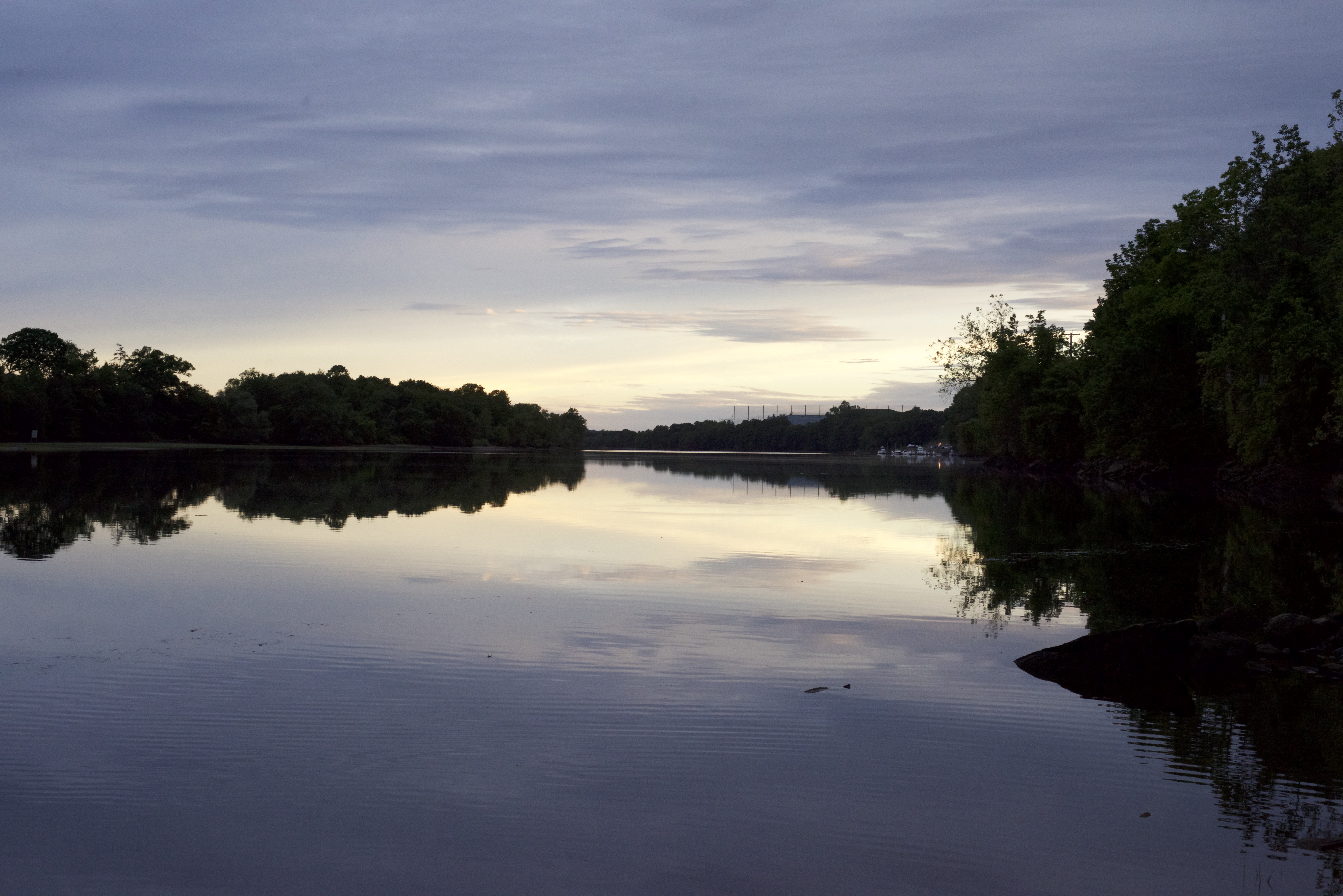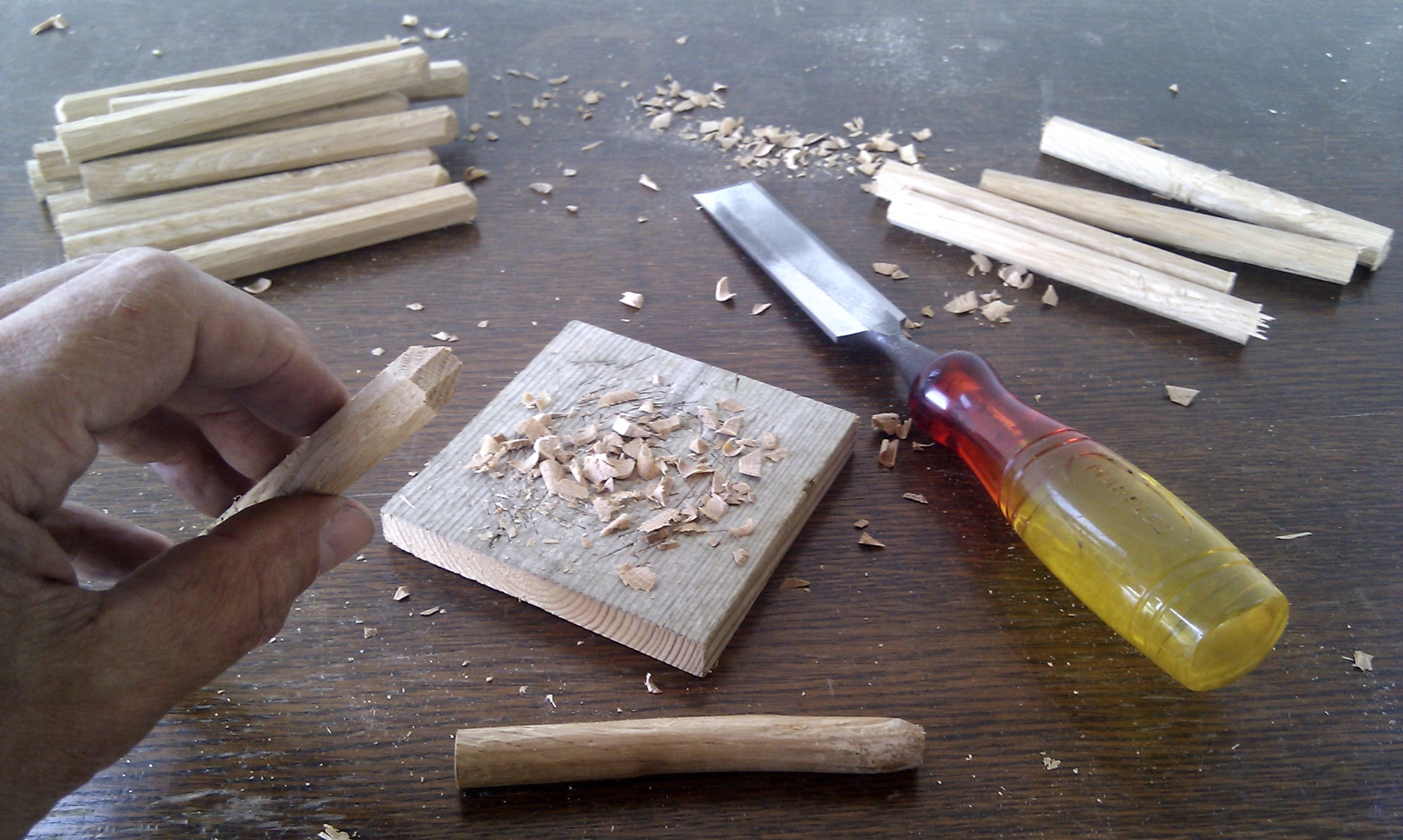|
Bull's Bridge
Bull's Bridge is a single-lane vehicular wooden covered bridge across the Housatonic River in the town of Kent, Connecticut, close to the state border with New York. The first instance of a bridge at this location was constructed by Jacob and Isaac Bull in 1760, which gave the bridge its name. Popular legend suggests that George Washington crossed the bridge with the Bulls' assistance while still under construction. The current bridge was built in 1842 from timber, with additional supports added in the 19th and 20th centuries. Built with a Town lattice design, the bridge has reinforced trusswork visible on the interior. At the time of its nomination to the National Register of Historic Places the roof had wood shingles. It is historically significant as one of three surviving covered bridges in Connecticut, and was listed on the National Register of Historic Places in 1972. Location The bridge is long and crosses the Housatonic River in the northwest corner of the state, ha ... [...More Info...] [...Related Items...] OR: [Wikipedia] [Google] [Baidu] |
Housatonic River
The Housatonic River ( ) is a river, approximately long,U.S. Geological Survey. National Hydrography Dataset high-resolution flowline dataThe National Map , accessed April 1, 2011 in western Massachusetts and western Connecticut in the United States. It flows south to southeast, and drains about of southwestern Connecticut into Long Island Sound. Its Drainage basin, watershed is just to the west of the watershed of the lower Connecticut River. History Indigenous history Indigenous people began using the river area for fishing and hunting at least 6,000 years ago. By 1600, the inhabitants were mostly Mohicans and may have numbered 30,000. The river's name is derived from the Mohican phrase ''"usi-a-di-en-uk"'', translated as "beyond the mountain place" or "river of the mountain place".Housatonic Valley Association. Cornwall Bridge, CT"History of the Housatonic Valley." Accessed 2015-10-1. It is referred to in the deed by which a group of twelve colonists called "The Proprietor ... [...More Info...] [...Related Items...] OR: [Wikipedia] [Google] [Baidu] |
Hartford, Connecticut
Hartford is the capital city of the U.S. state of Connecticut. It was the seat of Hartford County until Connecticut disbanded county government in 1960. It is the core city in the Greater Hartford metropolitan area. Census estimates since the 2010 United States census have indicated that Hartford is the fourth-largest city in Connecticut with a 2020 population of 121,054, behind the coastal cities of Bridgeport, New Haven, and Stamford. Hartford was founded in 1635 and is among the oldest cities in the United States. It is home to the country's oldest public art museum (Wadsworth Atheneum), the oldest publicly funded park (Bushnell Park), the oldest continuously published newspaper (the ''Hartford Courant''), and the second-oldest secondary school (Hartford Public High School). It is also home to the Mark Twain House, where the author wrote his most famous works and raised his family, among other historically significant sites. Mark Twain wrote in 1868, "Of all the beautifu ... [...More Info...] [...Related Items...] OR: [Wikipedia] [Google] [Baidu] |
Howe Truss
A Howe truss is a truss bridge consisting of chords, verticals, and diagonals whose vertical members are in tension and whose diagonal members are in compression. The Howe truss was invented by William Howe in 1840, and was widely used as a bridge in the mid to late 1800s. Development The earliest bridges in North America were made of wood, which was abundant and cheaper than stone or masonry. Early wooden bridges were usually of the Towne lattice truss or Burr truss design. Some later bridges were McCallum trusses (a modification of the Burr truss). About 1840, iron rods were added to wooden bridges. The Pratt truss used wooden vertical members in compression with diagonal iron braces. The Howe truss used iron vertical posts with wooden diagonal braces. Both trusses used counter-bracing, which was becoming essential now that heavy railroad trains were using bridges. In 1830, Stephen Harriman Long received a patent for an all-wood parallel chord truss bridge. Long's bridge con ... [...More Info...] [...Related Items...] OR: [Wikipedia] [Google] [Baidu] |
Comstock's Bridge
Comstock's Bridge, also known as the Comstock Covered Bridge, is a covered bridge located in East Hampton, Connecticut, spanning the Salmon River, Built in 1840, it is one of only three historical covered bridges in the state. It is open to pedestrian traffic in a small park off Comstock Bridge Road. The bridge was listed on the National Register of Historic Places on January 1, 1976. Description and history Comstock's Bridge is located in southeastern East Hampton, near the junction of Comstock Bridge Road and Colchester Avenue (Connecticut Route 16). The bridge consists of two spans: its main span is a Howe truss, long, with a roadbed wide. That span is covered by a gabled roof and sheathed in vertical board siding. Gates at either end of the bridge limit access to pedestrians. A secondary span, in length, connects the bridge to the eastern shore. This span is uncovered; its trusses are sheathed in vertical siding with peaked caps. The bridge abutments are a combina ... [...More Info...] [...Related Items...] OR: [Wikipedia] [Google] [Baidu] |
West Cornwall Covered Bridge
The West Cornwall Covered Bridge (an earlier incarnation was known as the Hart Bridge) is a wooden covered lattice truss bridge carrying the Sharon-Goshen Turnpike over the Housatonic River in the town of Cornwall, Connecticut. Records indicate that a bridge may have been in place in this location as early as 1762. A previous bridge was destroyed in the flood of 1837 and a new bridge was constructed in 1841. This bridge would also be destroyed and the current bridge would be completed circa 1864. Utilizing the central pier from the previous incarnation, despite the Town lattice being able to withstand the weight and single span, the bridge has two spans. The later addition of queen trusses and supports gives the bridge an unusual appearance. Modernization of the bridge in 1968 and 1973 has continued to let the bridge handle traffic. It was added to the National Register of Historic Places in 1975. History Located at the north-south and east-west roadway section of the riversid ... [...More Info...] [...Related Items...] OR: [Wikipedia] [Google] [Baidu] |
Treenail
A treenail, also trenail, trennel, or trunnel, is a wooden peg, pin, or dowel used to fasten pieces of wood together, especially in timber frames, covered bridges, wooden shipbuilding and boat building. It is driven into a hole bored through two (or more) pieces of structural wood (mortise and tenon). History and general use The use of wood as a tenon can be traced back over 7,000 years, as archaeologist have found traces of wood nails in the excavation of early Germanic sites. Trenails are extremely economical and readily available, making them a common early building material. Black Locust is a favorite wood when making trunnels in shipbuilding in North America and English Oak in Europe due to their strength and rot resistance, while red oak is typical in buildings. Traditionally treenails and pegs were made by splitting bolts of wood with a froe and shaping them with a drawknife on a shaving horse. Treenails are cut from a single piece of wood and perform well because of the ... [...More Info...] [...Related Items...] OR: [Wikipedia] [Google] [Baidu] |
Connecticut State Highway Department
The Connecticut Department of Transportation (often referred to as CTDOT and occasionally ConnDOT, or CDOT) is responsible for the development and operation of highways, railroads, mass transit systems, ports and waterways in Connecticut. Connecticut Department of Transportation. Retrieved on November 12, 2009. "Connecticut Department of Transportation 2800 Berlin Turnpike Newington CT 06111" CTDOT manages and maintains the system, and runs most of the state's ports along and the |
Queen Post
A queen post is a tension member in a truss that can span longer openings than a king post truss. A king post uses one central supporting post, whereas the queen post truss uses two. Even though it is a tension member, rather than a compression member, they are commonly still called a post. A queen post is often confused with a queen strut, one of two compression members in roof framing which do not form a truss in the engineering sense. The double punch truss appeared in Central Europe during the Renaissance. Architecture A queen-post bridge has two uprights, placed about one-third of the way from each end of the truss. They are connected across the top by a beam and use a diagonal brace between the outer edges. The central square between the two verticals is either unbraced (on shorter spans), or has one or two diagonal braces for rigidity. A single diagonal reaches between opposite corners; two diagonal braces may either reach from the bottom of each upright post to the cente ... [...More Info...] [...Related Items...] OR: [Wikipedia] [Google] [Baidu] |
Ithiel Town
Ithiel Town (October 3, 1784 – June 13, 1844) was an American architect and civil engineer. One of the first generation of professional architects in the United States, Town made significant contributions to American architecture in the first half of the 19th century. His work, in the Federal and revivalist Greek and Gothic revival architectural styles, was influential and widely copied. Life and works Town was born in Thompson, Connecticut, to Archelaus Town, a farmer, and Martha (Johnson) Town. He trained with the eminent Asher Benjamin in Boston and began his own professional career with the Asa Gray House (1810). His earliest important architectural works include Center Church (1812–1815), and Trinity Church (1813–1816), both on the New Haven Green in New Haven, Connecticut. He demonstrated his virtuosity as an engineer by constructing the spire for Center Church inside the tower and then raising it into place in less than three hours using a special windlass ... [...More Info...] [...Related Items...] OR: [Wikipedia] [Google] [Baidu] |
Dover Plains, New York
Dover Plains is a hamlet and census-designated place (CDP) in Dutchess County, New York, United States. The population was 1,323 at the 2010 census. It is part of the Poughkeepsie– Newburgh– Middletown Metropolitan Statistical Area. Dover Plains is in the northern part of the town of Dover on NY Route 22. Metro-North Railroad has a Harlem Line station here, bringing commuters to New York City. This station was the line's northern terminus until 1852 when the line was carried farther north to Chatham. History It is not known when or by whom the first settlement was made in Dover Plains. Lawrence and Joseph ran the first store under the name Belding & Co. In 1802 the village had less than a dozen buildings. In 1806 Jonathan Mabbett and James Ketcham bought out the Beldings and ran the business under the name Mabbett & Ketcham. When the town of Dover was formed from the town of Pawling, James Ketcham became the first town clerk. George Casey was the first postmaster. M ... [...More Info...] [...Related Items...] OR: [Wikipedia] [Google] [Baidu] |
Covered Bridges Today
''Covered Bridges Today'' is a non-fiction book on the architecture of covered bridges in the United States. The book was written by Brenda Krekeler and published by Daring Books in 1989. ''Covered Bridges Today'' is a frequently cited source on the topic of covered bridges and serves as a record of numerous covered bridges that have since been dismantled or demolished since the book's publication. Krekeler's text includes 412 covered bridges in fourteen states with a complete record of all 142 covered bridges in Ohio during its writing in 1986 and 1987. The work has been utilized in numerous citations by later publications including Historic American Engineering Record surveys and ''New England's Covered Bridges: A Complete Guide'', ''Indiana Covered Bridges'' and ''Covered Bridges in Virginia''. Background Covered bridges are timber-truss bridges with a roof and siding which, in most covered bridges, create an almost complete enclosure. The purpose of the covering is to keep ... [...More Info...] [...Related Items...] OR: [Wikipedia] [Google] [Baidu] |



.jpg)

_PA.jpg)

